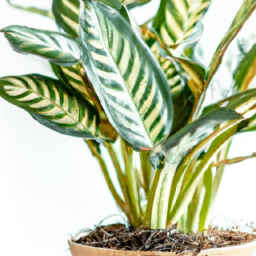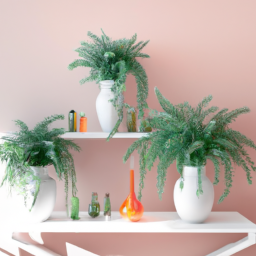
The Importance of Air-Purifying Plants in Improving Indoor Air Quality
Indoor air quality is a critical aspect of our overall well-being, yet it is often overlooked. We spend a significant amount of time indoors, whether it’s at home, in the office, or other enclosed spaces. Unfortunately, the air we breathe indoors can be filled with various pollutants, such as volatile organic compounds (VOCs), dust, mold spores, and even bacteria.
While air purifiers and ventilation systems can help mitigate some of these pollutants, one often overlooked solution is the use of air-purifying plants. These plants have the remarkable ability to filter and purify the air, making it cleaner and healthier for us to breathe. In this comprehensive guide, we will explore the importance of air-purifying plants and how they can significantly improve indoor air quality.
1. How Do Air-Purifying Plants Work?
Air-purifying plants are not just aesthetically pleasing additions to our indoor spaces; they actively remove harmful substances from the air. Through a process known as phytoremediation, these plants absorb pollutants through their leaves and roots, breaking them down or storing them in their tissues. They can effectively remove toxins such as formaldehyde, benzene, and trichloroethylene, which are commonly found in indoor environments.
Additionally, air-purifying plants release oxygen and moisture into the air, creating a more pleasant and healthier environment. The increased oxygen levels can improve cognitive function, reduce stress, and enhance overall well-being. The moisture released by these plants can also help combat dryness, which is particularly beneficial during the winter months when indoor humidity tends to be low.
It’s important to note that while air-purifying plants can significantly improve indoor air quality, they should not be seen as a complete replacement for proper ventilation and air purification systems. Rather, they should be used as a complementary measure to create a healthier indoor environment.
2. Top Air-Purifying Plants for Cleaner Indoor Air
There is a wide variety of air-purifying plants available, each with its unique set of benefits. Here, we will explore some of the top air-purifying plants that are known for their ability to filter and purify indoor air:
Snake Plant (Sansevieria trifasciata): This popular plant is highly effective at removing formaldehyde, benzene, and xylene from the air. It is also known for its ability to release oxygen at night, making it an excellent choice for bedrooms.
Spider Plant (Chlorophytum comosum): Spider plants are known for their ability to remove formaldehyde and xylene from the air. They are easy to care for and can thrive in various lighting conditions, making them suitable for different indoor spaces.
Peace Lily (Spathiphyllum wallisii): Peace lilies are not only beautiful but also excellent at removing formaldehyde, benzene, and trichloroethylene from the air. They thrive in low-light conditions, making them ideal for areas with limited sunlight.
English Ivy (Hedera helix): English ivy is a versatile plant that can effectively filter airborne mold spores, making it an excellent choice for individuals with allergies or asthma. It is also known for its ability to remove formaldehyde from the air.
Bamboo Palm (Chamaedorea seifrizii): Bamboo palms are known for their ability to remove formaldehyde, benzene, and trichloroethylene from the air. They are also effective at adding moisture to the environment, making them suitable for dry indoor spaces.
Golden Pothos (Epipremnum aureum): Golden pothos is a hardy plant that can effectively remove formaldehyde, benzene, and xylene from the air. It is known for its trailing vines, making it a popular choice for hanging baskets or as a cascading plant.
3. How to Care for Air-Purifying Plants
While air-purifying plants can significantly improve indoor air quality, they do require proper care to thrive and continue purifying the air effectively. Here are some essential care tips for air-purifying plants:
Light: Most air-purifying plants thrive in bright, indirect light. However, it’s essential to research the specific light requirements of the plants you choose, as some may prefer low-light conditions.
Water: Proper watering is crucial for the health of air-purifying plants. It’s important to avoid overwatering or allowing the plants to sit in standing water, as this can lead to root rot. Instead, water the plants when the top inch of soil feels dry.
Temperature and Humidity: Air-purifying plants generally prefer temperatures between 60-75°F (15-24°C). They also thrive in moderate humidity levels, so it may be necessary to mist the plants occasionally or place them near a humidifier during dry periods.
Soil and Fertilizer: Use well-draining soil specifically formulated for indoor plants. Fertilize the plants regularly during the growing season with a balanced, water-soluble fertilizer to promote healthy growth.
Pest Control: Keep an eye out for common indoor plant pests such as spider mites or mealybugs. If pests are present, treat them promptly with organic pest control methods or insecticidal soap.
Regular Maintenance: Regularly remove any dead leaves or debris from the plants to maintain their overall health and appearance. Prune the plants as needed to encourage bushier growth.
By following these care tips, you can ensure that your air-purifying plants thrive and continue to improve the indoor air quality of your living or working spaces.
In conclusion, air-purifying plants play a crucial role in improving indoor air quality. They have the remarkable ability to filter and purify the air by removing harmful pollutants and releasing oxygen and moisture. By incorporating air-purifying plants into our indoor spaces and providing them with proper care, we can create a healthier and more pleasant environment to live and work in. So, why not bring some greenery into your indoor spaces and breathe cleaner air?
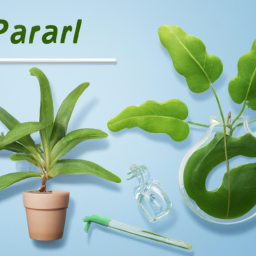
Top 10 Air-Purifying Plants for Cleaner Indoor Air
Having clean and fresh air is vital for our overall well-being, especially when spending a significant amount of time indoors. Air-purifying plants are a natural and effective way to improve indoor air quality by removing harmful toxins and pollutants. In this comprehensive guide, we will explore the top 10 air-purifying plants that can help you achieve cleaner and healthier indoor air.
1. Snake Plant (Sansevieria trifasciata)
The Snake Plant, also known as Mother-in-Law’s Tongue, is a popular choice for indoor spaces. It is highly effective in removing formaldehyde, trichloroethylene, and benzene from the air. This plant has long, upright leaves with green and yellow variegation, adding a touch of elegance to any room. Snake Plants are low-maintenance and can thrive in various lighting conditions, making them perfect for beginners.
When caring for a Snake Plant, ensure that the soil is well-drained and allow it to dry out between waterings. It can tolerate low light but prefers indirect sunlight. Place it in your bedroom to enjoy its air-purifying benefits while you sleep.
2. Peace Lily (Spathiphyllum wallisii)
The Peace Lily is not only aesthetically pleasing with its beautiful white flowers but also an excellent air purifier. It effectively removes common indoor air pollutants such as formaldehyde, benzene, and xylene. Peace Lilies thrive in low light conditions, making them ideal for rooms with limited sunlight.
When caring for a Peace Lily, keep the soil consistently moist but not soggy. It is important to note that Peace Lilies are toxic to pets if ingested, so it’s best to keep them out of reach. Place a Peace Lily in your living room or office space to enhance the air quality and create a serene atmosphere.
3. Spider Plant (Chlorophytum comosum)
The Spider Plant is a resilient and easy-to-grow plant that effectively removes formaldehyde and xylene from the air. It features long, arching leaves with green and white stripes, adding a refreshing touch to any indoor space. Spider Plants are known for their ability to produce baby spider plants, which can be propagated and shared with friends and family.
When caring for a Spider Plant, place it in bright, indirect sunlight and water it when the top inch of soil feels dry. Spider Plants are non-toxic, making them safe for pets and children. Display this air-purifying plant in your kitchen or bathroom for a natural and stylish touch.
4. Aloe Vera (Aloe barbadensis)
Aloe Vera is not only a popular plant for its medicinal properties but also an effective air purifier. It helps remove formaldehyde and benzene from the air, commonly found in cleaning products and paints. Aloe Vera plants are succulents with thick, fleshy leaves filled with gel-like sap.
When caring for an Aloe Vera plant, place it in bright, indirect sunlight and water it deeply but infrequently. Allow the soil to dry out between waterings to prevent root rot. Aloe Vera plants are safe for pets and can be placed in any room to enhance the air quality while adding a touch of greenery.
5. Bamboo Palm (Chamaedorea seifrizii)
The Bamboo Palm, also known as the Reed Palm, is a beautiful and versatile plant that excels in purifying the air. It effectively removes formaldehyde, benzene, and trichloroethylene from indoor environments. The Bamboo Palm features feathery and arching fronds, creating a tropical ambiance.
When caring for a Bamboo Palm, place it in bright, indirect sunlight and water it regularly to keep the soil evenly moist. This plant thrives in humid conditions, making it an excellent choice for bathrooms or kitchens. Enjoy the air-purifying benefits of the Bamboo Palm while adding a touch of natural elegance to your home or office.
6. Golden Pothos (Epipremnum aureum)
The Golden Pothos, also known as Devil’s Ivy, is a popular choice for indoor spaces due to its low maintenance and air-purifying qualities. It effectively removes formaldehyde, benzene, and carbon monoxide from the air. The Golden Pothos features heart-shaped leaves with variegated patterns, adding a touch of beauty to any room.
When caring for a Golden Pothos, place it in bright, indirect sunlight or low light conditions. Water the plant when the top inch of soil feels dry. This plant is toxic to pets if ingested, so it’s important to keep it out of their reach. Enhance the air quality of your living room or bedroom with the Golden Pothos while enjoying its cascading foliage.
7. English Ivy (Hedera helix)
English Ivy is a classic and versatile plant that not only adds a touch of elegance but also improves indoor air quality. It effectively removes formaldehyde, benzene, and airborne mold spores. English Ivy features dark green leaves with a trailing growth habit, making it perfect for hanging baskets or as a ground cover.
When caring for English Ivy, place it in bright, indirect sunlight or low light conditions. Keep the soil evenly moist but not waterlogged. English Ivy is toxic to pets, so it’s important to keep it out of their reach. Use English Ivy to create a green accent wall or as a natural air purifier in your home or office.
8. Rubber Plant (Ficus elastica)
The Rubber Plant is a popular choice for indoor spaces due to its large, glossy leaves and air-purifying abilities. It effectively removes formaldehyde from the air, commonly found in household cleaning products. Rubber Plants are easy to care for and can thrive in a variety of lighting conditions.
When caring for a Rubber Plant, place it in bright, indirect sunlight and water it when the top inch of soil feels dry. Wipe the leaves occasionally to remove dust and keep them shiny. Rubber Plants are toxic to pets, so it’s important to keep them out of their reach. Add a touch of natural beauty and cleaner air to your living room with a Rubber Plant.
9. Boston Fern (Nephrolepis exaltata)
The Boston Fern is a classic and elegant plant that not only enhances indoor aesthetics but also improves air quality by removing formaldehyde and xylene. It features delicate, feathery fronds that create a lush and refreshing atmosphere.
When caring for a Boston Fern, place it in bright, indirect sunlight and keep the soil evenly moist. Mist the fronds occasionally to provide the humidity it craves. Boston Ferns are non-toxic, making them safe for pets. Hang a Boston Fern in your bathroom or place it in a decorative pot to enjoy its air-purifying qualities.
10. Chinese Evergreen (Aglaonema)
The Chinese Evergreen is a beautiful and versatile plant that thrives in low light conditions and effectively removes toxins such as formaldehyde and benzene from the air. It features attractive, variegated leaves in shades of green, silver, and red.
When caring for a Chinese Evergreen, place it in low to medium indirect sunlight and water it when the top inch of soil feels dry. This plant is toxic to pets, so it’s important to keep it out of their reach. Add a touch of color and cleaner air to your office or bedroom with a Chinese Evergreen.
By incorporating these top 10 air-purifying plants into your indoor spaces, you can enjoy cleaner and healthier air while adding a touch of natural beauty to your surroundings. Remember to consider your lighting conditions, watering requirements, and pet safety when selecting and caring for these plants. Breathe easy and reap the benefits of cleaner indoor air with these air-purifying plants.

How to Choose the Right Air-Purifying Plants for Your Home or Office
Indoor air pollution is a growing concern, and one way to combat it is by incorporating air-purifying plants into your home or office space. These plants not only add a touch of nature to your environment but also have the ability to filter out harmful pollutants and improve air quality. However, with so many options available, it can be overwhelming to choose the right air-purifying plants for your specific needs. In this comprehensive guide, we will walk you through the process of selecting the perfect plants for cleaner indoor air.
1. Assess Your Indoor Environment
The first step in choosing air-purifying plants is to assess your indoor environment. Consider factors such as lighting conditions, temperature, and humidity levels. Different plants have different requirements, and it’s important to select ones that will thrive in your specific setting. For example, if you have a room with low light, you’ll need to choose plants that can tolerate shade.
Additionally, take into account the size of your space. Larger rooms may require multiple plants to effectively purify the air, while smaller rooms may only need one or two. Understanding the unique characteristics of your indoor environment will help you narrow down your plant options.
Lastly, consider any potential allergies or sensitivities. Some people may have allergies to certain types of plants, so it’s important to choose air-purifying plants that won’t cause any adverse reactions.
2. Research Air-Purifying Plant Options
Once you have assessed your indoor environment, it’s time to research air-purifying plant options. There are numerous plants known for their air-purifying qualities, and each has its own unique benefits. Here are a few popular choices:
Snake Plant (Sansevieria trifasciata): This plant is known for its ability to filter out formaldehyde, a common indoor pollutant. It is also low-maintenance and can tolerate a variety of lighting conditions.
Peace Lily (Spathiphyllum): Peace lilies are excellent at removing toxins like benzene and trichloroethylene from the air. They also add a touch of elegance with their beautiful white flowers.
Spider Plant (Chlorophytum comosum): Spider plants are great for beginners as they are easy to care for and can effectively remove formaldehyde and xylene from the air.
English Ivy (Hedera helix): English ivy is a versatile plant that can be grown in hanging baskets or as a ground cover. It is known for its ability to filter out airborne mold and other allergens.
These are just a few examples, and there are many other air-purifying plants to choose from. Take the time to research each plant’s specific air-purifying qualities and determine which ones align with your needs and preferences.
3. Consider Maintenance and Care
Before making your final plant selections, consider the maintenance and care requirements of each plant. Some air-purifying plants are more low-maintenance, while others require more attention. Factors to consider include watering frequency, sunlight exposure, and pruning needs.
If you have a busy lifestyle or lack a green thumb, opt for plants that are known for their resilience and ability to thrive in various conditions. On the other hand, if you enjoy tending to plants and have the time to dedicate to their care, you may opt for more high-maintenance options.
Additionally, consider the availability of plant resources in your area. Some plants may be harder to find or more expensive, so it’s important to choose plants that are accessible and fit within your budget.
Remember that proper care is essential for the longevity and effectiveness of air-purifying plants, so choose ones that you feel confident in maintaining.
In conclusion, selecting the right air-purifying plants for your home or office involves assessing your indoor environment, researching plant options, and considering maintenance requirements. By taking these steps, you can create a cleaner and healthier indoor environment while enjoying the beauty and benefits of nature. So go ahead, choose your air-purifying plants and breathe in the fresh, purified air!
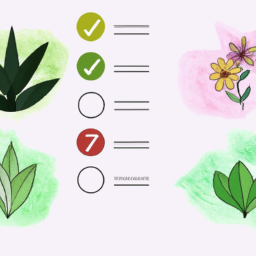
The Benefits of Air-Purifying Plants for Health and Well-being
Introduction
Air pollution is a significant concern in today’s world, especially in urban areas where indoor air quality can be equally or even more polluted than outdoor air. Breathing in polluted air can have detrimental effects on our health and overall well-being. However, there is a natural and effective solution to combat indoor air pollution – air-purifying plants. These green wonders not only beautify our living spaces but also work tirelessly to cleanse the air we breathe. In this comprehensive guide, we will delve into the numerous benefits of air-purifying plants for our health and well-being.
1. Improved Indoor Air Quality
The primary benefit of air-purifying plants is their ability to improve indoor air quality. They act as natural air filters, removing harmful pollutants and toxins from the air we breathe. Common indoor pollutants such as formaldehyde, benzene, xylene, and trichloroethylene can be found in everyday items like furniture, cleaning products, and synthetic materials. These pollutants can cause a range of health issues, including respiratory problems, allergies, and even more severe conditions like asthma. Air-purifying plants absorb these pollutants through their leaves and roots, effectively purifying the air and creating a healthier indoor environment.
Air-purifying plants work through a process called phytoremediation, where they absorb pollutants and convert them into harmless substances. Some plants are particularly efficient at removing specific toxins. For example, the Peace Lily (Spathiphyllum) is excellent at removing formaldehyde, while the Spider Plant (Chlorophytum comosum) is known for its ability to combat carbon monoxide and benzene. By strategically placing these plants in our homes and offices, we can significantly reduce the concentration of indoor air pollutants and enjoy cleaner, fresher air.
2. Enhanced Respiratory Health
Breathing in clean air is essential for maintaining good respiratory health. Air-purifying plants not only remove pollutants from the air but also increase humidity levels, which can benefit our respiratory system. Many indoor environments, especially during the winter months or in air-conditioned spaces, suffer from low humidity levels. This dry air can cause dry throat, itchy eyes, and irritated nasal passages. By releasing moisture into the air through a process called transpiration, air-purifying plants help alleviate these symptoms and promote healthier respiratory function.
Moreover, certain air-purifying plants, such as Aloe Vera (Aloe barbadensis) and English Ivy (Hedera helix), have been found to effectively reduce airborne mold spores. Mold can trigger allergies and respiratory problems, especially in individuals with pre-existing conditions like asthma or compromised immune systems. By incorporating these plants into our indoor spaces, we can minimize the presence of mold spores and create a healthier living environment for ourselves and our loved ones.
3. Stress Reduction and Improved Mental Health
In addition to their physical health benefits, air-purifying plants also contribute to our mental well-being. Numerous studies have shown that exposure to nature and greenery can have a positive impact on our mental health, reducing stress levels and improving overall mood. The presence of indoor plants has been linked to increased feelings of calmness, relaxation, and improved concentration.
Air-purifying plants not only provide visual appeal but also release oxygen and phytoncides, organic compounds that have been found to lower stress levels and improve cognitive function. These natural stress-relievers promote a sense of tranquility and can help combat the negative effects of a busy, fast-paced lifestyle. By surrounding ourselves with air-purifying plants, we create a soothing and peaceful atmosphere that enhances our mental well-being.
Conclusion
Air-purifying plants offer a multitude of benefits for our health and well-being. By improving indoor air quality, enhancing respiratory health, and reducing stress levels, these green companions contribute to a healthier and more enjoyable indoor environment. Incorporating air-purifying plants into our homes, offices, and other indoor spaces is a simple yet effective way to combat the harmful effects of indoor air pollution. So, let nature into your life and reap the rewards of cleaner air and a healthier lifestyle.
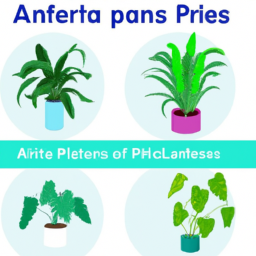
Tips for Caring and Maintaining Air-Purifying Plants for Long-lasting Effectiveness
Indoor air pollution is a growing concern in today’s world, with various sources contributing to the deterioration of air quality. One effective way to combat this issue is by incorporating air-purifying plants into your indoor spaces. These plants not only add a touch of greenery to your surroundings but also have the ability to filter out harmful toxins and pollutants, providing you with cleaner and fresher air to breathe. To ensure the long-lasting effectiveness of these air-purifying plants, it is essential to provide them with proper care and maintenance. In this comprehensive guide, we will walk you through some valuable tips to help you care for and maintain your air-purifying plants.
Choosing the Right Plants for Your Indoor Space
Before diving into the care and maintenance aspects, it is crucial to select the right air-purifying plants that are suitable for your indoor environment. Consider factors such as lighting conditions, temperature, and humidity levels in your space. Some popular air-purifying plants include the Spider Plant, Peace Lily, Snake Plant, and Aloe Vera. These plants are known for their ability to thrive indoors and efficiently filter out pollutants.
Once you have chosen the appropriate plants, it’s time to focus on their care and maintenance.
Providing Adequate Lighting and Watering
Lighting plays a vital role in the growth and overall health of air-purifying plants. Most of these plants prefer bright, indirect light, so place them near windows or in well-lit areas of your home or office. However, avoid exposing them to direct sunlight for extended periods as it may lead to leaf burn.
When it comes to watering, it is essential to strike a balance. Overwatering can cause root rot, while underwatering can lead to dryness and wilting. The frequency of watering depends on factors such as plant species, pot size, and environmental conditions. As a general rule of thumb, check the soil moisture level before watering. If the top inch of soil feels dry, it’s time to water your plants. Ensure proper drainage by using pots with drainage holes and avoid leaving standing water in saucers.
Fertilizing your air-purifying plants is also crucial for their long-term health. Use a balanced, water-soluble fertilizer once a month during the growing season to provide them with essential nutrients.
Maintaining Optimal Humidity Levels and Temperature
Air humidity and temperature are significant factors that influence the well-being of air-purifying plants. Most indoor plants thrive in moderate humidity levels ranging from 40% to 60%. If the air in your space is too dry, especially during winter months when heating systems are active, consider using a humidifier or placing a tray filled with water near your plants to increase humidity. On the other hand, if the air is excessively humid, ensure proper ventilation to prevent the growth of mold or fungal diseases.
Similarly, maintaining an optimal temperature is crucial for the health of your air-purifying plants. Most indoor plants prefer temperatures between 60°F and 75°F (15°C to 24°C). Avoid exposing them to extreme temperature fluctuations, such as drafts from windows or doors, as it can stress the plants and hinder their growth.
Regularly monitor the humidity and temperature levels in your indoor space and make necessary adjustments to create a favorable environment for your air-purifying plants.
Pruning, Cleaning, and Pest Control
Pruning is an essential part of plant care that helps maintain the shape, size, and overall appearance of your air-purifying plants. Regularly inspect your plants for any dead or yellowing leaves, and use clean, sharp pruning shears to remove them. Pruning also encourages new growth and prevents overcrowding, allowing better air circulation around the plants.
Cleaning the leaves of your air-purifying plants is another vital task. Dust and debris can accumulate on the leaves, blocking their ability to photosynthesize effectively. Gently wipe the leaves with a damp cloth or use a soft brush to remove any dust. This not only enhances the plant’s appearance but also ensures optimal air purification.
Pest infestations can negatively impact the health of your air-purifying plants. Keep a close eye on your plants for any signs of pests such as aphids, mealybugs, or spider mites. If detected, treat the infestation promptly using organic insecticidal soaps or horticultural oils, following the instructions carefully to avoid any harm to your plants.
By following these tips and incorporating them into your plant care routine, you can ensure the long-lasting effectiveness of your air-purifying plants, providing you with cleaner and healthier indoor air.
Frequently Asked Questions (FAQ)
1. What are air-purifying plants?
Air-purifying plants are indoor plants that have the ability to remove harmful pollutants and toxins from the air, helping to improve indoor air quality.
2. How do air-purifying plants clean the air?
Air-purifying plants absorb pollutants through their leaves and roots. They then convert these pollutants into harmless substances through a process called phytoremediation.
3. What are some common air-purifying plants?
Some common air-purifying plants include Snake Plant, Spider Plant, Peace Lily, Aloe Vera, and English Ivy.
4. How many air-purifying plants do I need for cleaner indoor air?
The number of air-purifying plants you need depends on the size of your space. As a general rule, it is recommended to have at least one air-purifying plant per 100 square feet of indoor space.
5. Do air-purifying plants require special care?
While air-purifying plants are generally low-maintenance, they still require regular watering, proper sunlight, and occasional fertilization. Each plant may have specific care requirements, so it’s important to research and understand the needs of the specific plants you choose.
6. Can air-purifying plants help with allergies?
Air-purifying plants can help reduce allergens in the air, such as dust and pollen, which may provide relief for some allergy sufferers. However, it’s important to note that individual reactions to allergens can vary, and air-purifying plants may not completely eliminate all allergens.
7. Are air-purifying plants safe for pets?
While many air-purifying plants are safe for pets, some plants can be toxic if ingested. It’s important to research and choose pet-friendly air-purifying plants, and also keep them out of reach of curious pets.
8. Can air-purifying plants improve mental health?
Studies have shown that indoor plants, including air-purifying plants, can have a positive impact on mental health by reducing stress, improving mood, and increasing productivity.
9. Can air-purifying plants be grown in any indoor environment?
Air-purifying plants have different light and temperature requirements. While some plants can thrive in low-light conditions, others may require bright indirect sunlight. It’s important to choose plants that are suitable for the specific indoor environment.
10. Where can I purchase air-purifying plants?
Air-purifying plants can be purchased at local nurseries, garden centers, or online plant retailers. Additionally, many home improvement stores and supermarkets also carry a variety of air-purifying plants.
Dr. Olivia Green is a botanist with over two decades of experience in indoor plant cultivation. She holds a Ph.D. in Plant Biology and has dedicated her career to researching plant behavior in controlled environments. Dr. Green is passionate about helping plant enthusiasts master the art of indoor gardening through her extensive knowledge and practical insights.


